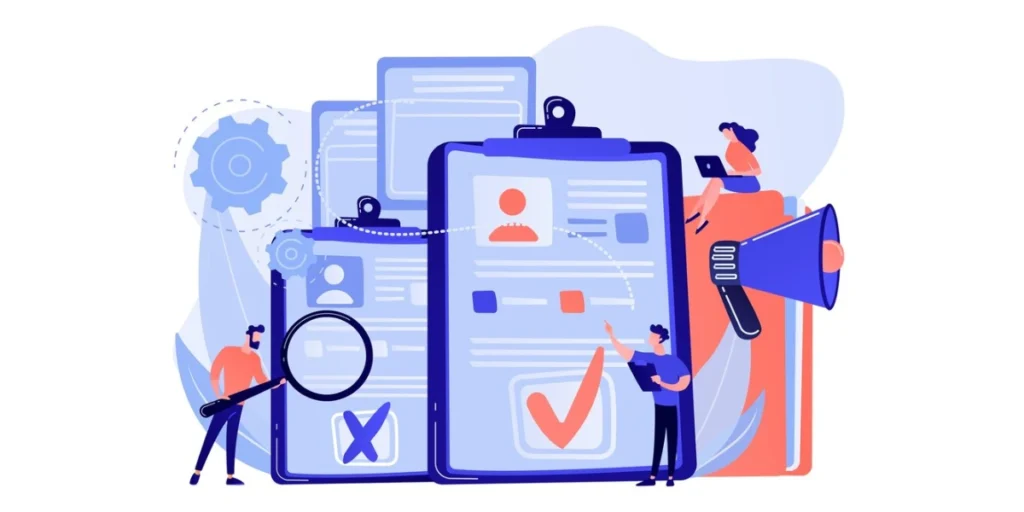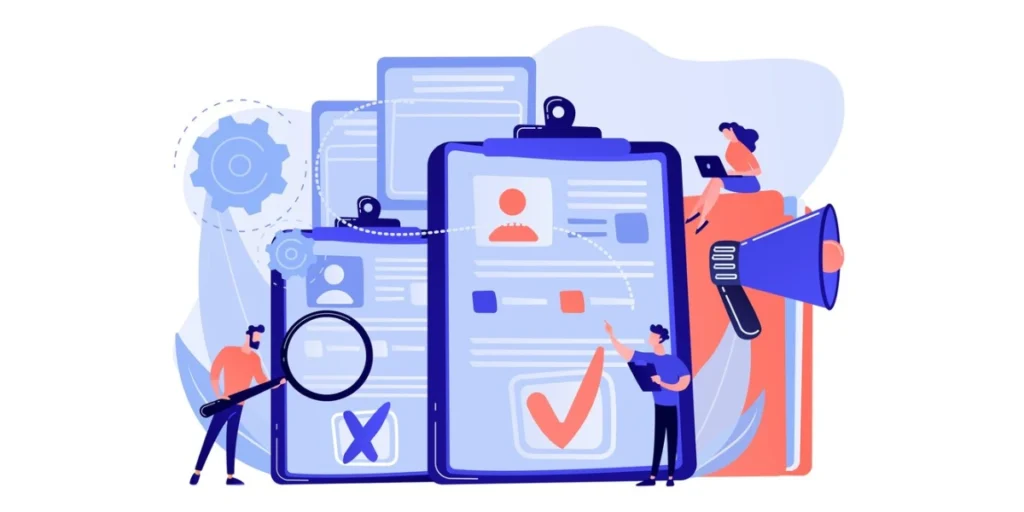QR Codes have revolutionized how we access information and conduct various activities.
These tiny pixelated patterned squares can be seen everywhere, from product labels to restaurant menus.
Yet, their true potential often remains underestimated.
By the end of this article, you will learn: why use QR Codes.
So let’s get started and know what QR Codes are.
Read this ultimate guide to know all about QR Codes
A. The basics of QR Codes

Fundamentally, QRs are two-dimensional barcodes distinguished by a distinctive matrix of black squares on a white square grid.
QRs possess the capability to store an extensive range of information, encompassing text, URLs, contact details, and beyond.
This makes them more versatile than a barcode. Know the difference between them.
Originating in mid-1990s Japan, the QR Code was created by Denso Wave, a Toyota subsidiary.
It aimed to improve the tracking of automotive parts by surpassing traditional barcode limitations—ensuring quick decoding and storing more information.
In the 21st century, QRs reached a tipping point. Their adoption surged across various industries and applications, marking a paradigm shift in how we engage with information.
From contactless payments and event check-ins to restaurant menus and COVID-19 contact tracing, QRs have become indispensable tools for efficiency, convenience, and safety.
Generate a QR Code For Your Unique Case
START TODAY!
B. Why use QR Codes: Know the benefits

QRs offer numerous benefits across various applications due to their versatility, ease of use, and efficiency. Some key advantages include:
1. Convenience
QRs provide a quick and convenient way for users to access information or perform actions by simply scanning the code with their smartphones. This streamlines processes such as making payments, accessing websites, or downloading apps.
2. Contactless transactions
In the context of the COVID-19 pandemic, QRs have become instrumental in promoting contactless interactions. They enable touch-free transactions, check-ins, and information retrieval, contributing to health and safety measures.
3. Efficiency in marketing
QRs enhance marketing campaigns by providing a direct link between physical and digital marketing materials. They facilitate easy access to websites, promotions, or additional content, increasing engagement and interaction with the audience.
4. Cost-effectiveness
Implementing QRs is cost-effective compared to traditional methods of information dissemination. Businesses can use QRs on print materials, reducing the need for printed brochures or additional signage.
5. Tracking and analytics
QRs enable businesses to track user interactions and gather analytics. This data helps in assessing the effectiveness of marketing campaigns, understanding user behavior, and making informed decisions for future strategies.
6. Accessibility
QR Codes are accessible to a wide range of users with smartphones. They provide a universal and standardized method for linking physical objects to digital content. This makes information easily available to a broad audience.
7. Enhanced user engagement
QRs contribute to enhanced user engagement by providing a seamless and interactive experience.
Whether accessing product details, participating in surveys, or joining events, users can engage with content quickly through QRs.
8. Versatility
QRs can be applied in various contexts, including ticketing, event management, retail, education, healthcare, and more. Their adaptability makes them suitable for a wide array of industries and purposes.
9. Security
QRs can incorporate security features such as encryption and tokenization, ensuring the safety of sensitive information. This is particularly relevant in applications like mobile payments and ticketing.
10. Environmentally friendly
The use of QR Codes reduces the reliance on printed materials. This contributes to environmental sustainability by minimizing paper waste.
Want to know more benefits of using a QR Code? Read this guide!
C. Why use QR Codes: Use cases

If you’re a marketer or if you have a business, you can use QRs in numerous ways.
But do you know the “why” part of it? Let’s help you figure that out!
1. To ask for feedback or reviews
Feedback holds significant value across various industries, yet getting them is always a challenge.
By using QRs, you can encourage people to give reviews. Display them on doors, tables, or menus, or add them to your email communications.
The code conveniently directs customers to the survey or review platform. This streamlines the process for them to share their feedback.
2. To run a giveaway
In addition to offering an attractive deal, giveaways have the power to generate excitement.
To boost participation in giveaways, ensure that the entry process is easy.
Traditionally, giveaways were confined to a specific platform, such as an Instagram contest, or required participants to visit a designated URL.
However, relying on people’s memory to recall a URL can be a challenge.
A more efficient and user-friendly approach is to use a QR that swiftly directs people to the entry form.
This simplifies the process, making it fast and easy for participants to engage.
3. To share the restaurant menu
The restaurant sector experienced a substantial setback in 2020 due to COVID-19.
This prompted owners to find innovative ways to adapt to touchless environments.
Rather than distributing paper or reusable menus, consider using a QR to direct diners to a webpage featuring your complete menu.
4. To increase engagement on your social media pages
Say you’re a marketer or a business owner looking to increase your brand’s social media presence.
How would you go on to do that?
You can strategically place QRs on promotional materials like business cards, flyers, and product packaging.
This will help in seamlessly directing users to social media profiles or pages.
The mobile-friendly nature of QR interactions aligns well with social media usage patterns
The analytics provided by tracking scans offer valuable insights for optimizing strategies. This is crucial for you as a marketer/business owner.
5. To provide product information
The space available on a product package is limited, and excessive information can make it appear cluttered.
Using QRs on product packaging is an effective way to prompt customers to explore details about the product.
These QRs can lead to various resources. These could include promotional videos or a quick-start guide on assembling the product.
This not only reduces the risk of generating paper waste but also allows for more flexibility in design.
Moreover, if the QR directs users to a quick start guide, updates can be easily implemented without the need to reprint thousands of booklets.
6. To aid in event management
QRs are integral to event management, streamlining processes, and enhancing attendee experiences.
They facilitate seamless ticketing and registration through quick check-ins and access control.
Attendees can effortlessly retrieve event details, schedules, and speaker information by scanning QRs.
QRs also contribute to engagement by providing instant feedback, interactive displays, and facilitating cashless transactions for purchases.
Exhibitors benefit from QRs for lead retrieval, while the technology supports health and safety measures through contactless solutions.
Additionally, QRs enhance post-event communication by enabling feedback surveys and social media sharing.
7. To facilitate contactless payments
QRs play a pivotal role in contactless payments by providing a secure and efficient means for transactions.
Merchants generate QRs linked to specific payment amounts, enabling customers to swiftly complete transactions by scanning the code
Similarly, in peer-to-peer transactions, mobile wallet apps utilize QRs, allowing users to share payment information for quick and convenient transfers.
The speed, simplicity, and enhanced security of QR payments drive their widespread adoption. This has enabled seamless and secure contactless transactions across various settings.
8. To enhance the travel experience
QRs have become integral to the travel and tourism industry, streamlining various processes and enriching the overall experience for travelers.
From contactless check-ins at hotels and transportation services to providing instant access to detailed information about tourist attractions, QRs offer efficiency and convenience.
Digital tickets and boarding passes issued as QRs reduce reliance on paper documents. Their use in health declarations and contact tracing contributes to safety measures.
Additionally, QRs facilitate cashless transactions for travel-related expenses. They also play a role in navigation, language translation, terms translation, and feedback collection.
Travel agencies and destinations leverage QRs in promotional campaigns, directing users to special offers and exclusive content.
9. To contribute to a good cause
QRs play an important role in charitable donations by providing a user-friendly and efficient means for supporters to contribute.
Non-profit organizations use QRs on various platforms, including marketing materials, websites, and social media. This enables individuals to make instant donations with a simple scan.
At events, QRs on posters or tickets facilitate seamless on-the-spot contributions.
Whether used in mobile apps, or social media campaigns, QRs simplify the donation process. This helps make charities more accessible and convenient for supporters.
10. To increase app downloads
QRs significantly boost app downloads by streamlining the user journey and minimizing barriers to access.
Serving as a direct link between offline and online realms, these codes simplify the process of discovering and downloading mobile applications.
Whether featured on marketing materials, event promotions, print or digital media, QRs provide users with an immediate pathway to app installations.
These are not the only reasons for the question: Why use QR Codes?
Interested to know more? Read our comprehensive guide!
D. Best practices: Why use QR Codes

Incorporating QRs into business practices comes with several best practices that highlight their effectiveness:
1. Clarity of purpose
Communicate the purpose of the QR to users. Whether it’s for accessing information, making a payment, or downloading an app, users should know what to expect.
2. Mobile optimization
Ensure that the linked content is mobile-friendly and optimized for a seamless user experience on various devices. This is crucial for widespread accessibility.
3. Design and placement
Design QRs with high contrast and ensure they are placed where they can be easily scanned. Avoid distortion or interference with other graphics to maintain scanning reliability.
4. Error correction
Use QRs with error correction capabilities to ensure readability even if the code is partially damaged or obscured. This enhances the reliability of the scanning process.
5. Testing and quality control
Before deployment, thoroughly test QR Codes to verify their functionality and readability. Regularly check and update linked content to maintain relevance.
6. Consistent branding
Add QRs into your brand strategy by maintaining consistency in design elements. This helps users recognize and trust your QR Codes across various platforms.
7. Educate users
Provide instructions or a brief explanation for users unfamiliar with QR Codes. This can be especially important for older demographics or regions where QR Code usage is less common.
8. Dynamic QR Codes
Consider using dynamic QRs that allow for the modification of linked content without changing the QR Code itself. This flexibility is beneficial for updates and changes.
9. Security measures
If handling sensitive information, implement security measures such as encryption to protect user data. This is crucial for applications like mobile payments or personal identification.
10. Analytics and monitoring
Utilize analytics tools to monitor QR usage. This data provides insights into user behavior, allowing for adjustments to marketing strategies or the improvement of user experiences.
11. Appropriate size
Ensure that QR Codes are large enough to be easily scanned but not excessively large, which can affect their aesthetics and placement on materials.
12. Prominent call to action
Accompany QR Codes with a clear and compelling call to action. Inform users about the benefits they will gain by scanning the code, encouraging higher engagement.
13. Compliance with standards
Follow QR Code standards and guidelines to ensure compatibility across different scanning devices and applications. Always use a reputable QR Code service provider.
14. Regular updates
Regularly update the information linked to QR Codes to keep content current and prevent users from accessing outdated or irrelevant information.
Generate a QR Code For Your Unique Case
START TODAY!
E. FAQs: Why use QR Codes

1. Why should I use QR Codes in my business or marketing strategy?
QR Codes offer a range of benefits, primarily centered around convenience, efficiency, and user engagement.
They streamline processes such as payments, ticketing, and information retrieval, providing a quick and direct link between the physical and digital worlds.
QR Codes are cost-effective, environmentally friendly alternatives to traditional methods, reducing the reliance on printed materials.
Additionally, they facilitate contactless interactions, aligning with current health and safety concerns.
As technology continues to advance, the versatility and ease of use of QRs make them a valuable tool across diverse industries and applications.
2. How can QR Codes enhance user engagement?
QRs enhance user engagement by providing a seamless and interactive experience. Users can quickly access information, participate in surveys, or download apps with a simple scan. They are particularly effective in marketing campaigns, bridging the gap between offline and online channels.
The versatility of QRs allows businesses to create innovative and engaging strategies, capturing the attention and interest of their target audience.
QRs also contribute to real-time updates and tracking of user interactions, enabling businesses to tailor their marketing efforts for maximum impact.
3. Are QR Codes secure for transactions and sensitive information?
Yes, QRs can be secure for transactions and handling sensitive information.
When used in applications such as mobile payments or personal identification, QRs can incorporate security measures like encryption and tokenization.
These measures help protect user data and ensure the integrity of the information being transmitted.
Businesses must implement security best practices and stay updated on industry standards when using QRs for sensitive transactions.
4. How can I ensure the effectiveness of QRs in my marketing materials?
To ensure the effectiveness of QRs in marketing materials, consider factors such as clarity of purpose, mobile optimization, and consistent branding.
Communicate the intended action to users and design QRs with high contrast for easy scanning.
Ensure that the linked content is mobile-friendly and regularly test the QR Codes before deployment.
Consistency in branding helps users recognize and trust your QR Codes. Additionally, provide a prominent call to action and monitor analytics to gain insights into user behavior, allowing for adjustments to your marketing strategies.
5. Can QRs be used in various industries and applications?
Absolutely. QRs are versatile and find applications in various industries, including retail, healthcare, education, event management, and more.
They are used for tasks such as ticketing, inventory management, contactless payments, and educational interactions.
Their adaptability makes QR Codes a valuable tool for businesses looking to streamline processes, enhance user experiences, and stay at the forefront of technological advancements.
6. Are there any best practices to follow when using QRs?
Yes, several best practices enhance the effectiveness of QRs.
These include ensuring clarity of purpose, optimizing for mobile devices, designing with high contrast, and using error correction among others.
Consistent branding, education for users, dynamic QRs for flexibility, and regular updates to linked content also contribute to successful QR Code implementation.
Monitoring analytics, using appropriate sizing, and providing a prominent call to action are additional best practices to maximize the benefits of QRs in various applications.
Summing Up
QR Codes transcend mere pixelated patterns; they serve as gateways to a seamlessly integrated digital experience.
Whether you’re a business seeking to enhance your marketing strategy, an event organizer striving for streamlined operations, or an educator in search of interactive tools, QRs present a versatile solution.
If you’re still reading, you’ve learned everything about why use QR Codes. If you have any questions, let us know in the comments.
